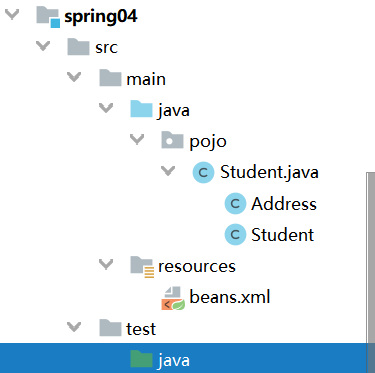依赖注入.
目录结构

1、构造器注入.
直接通过参数名(推荐) 还有两种(索引,和类型).
<!--按名字 beans.xml-->
<bean id="user" class="pojo.User">
<constructor-arg name="id" value="3"/>
<constructor-arg name="name" value="liuyou"/>
<constructor-arg name="pwd" value="password"/>
</bean>2、setter注入(重点).
- 依赖注入:set注入
- 依赖:bean对象的创建依赖容器
- 注入:bean对象中所有属性,由容器来注入
环境搭建.
1.beans.xml.
<?xml version="1.0" encoding="UTF-8"?>
<beans xmlns="http://www.springframework.org/schema/beans"
xmlns:xsi="http://www.w3.org/2001/XMLSchema-instance"
xsi:schemaLocation="http://www.springframework.org/schema/beans
https://www.springframework.org/schema/beans/spring-beans.xsd">
</beans>2.实体类.
@Data
public class Student {
private String name;//value
private Address address;//ref 复杂类型
private String[] books;//array
private List<String> hobbies;//list
private Map<String, String> card;//map
private Set<String> games;//set
private Properties info;//properties
private String wife; // null
}
@Data
class Address{
private String address;
}3.setter注入方式(beans.xml中beans标签下).
<!-- setter注入方式 -->
<bean id="student" class="pojo.Student">
<!-- 1.普通值value -->
<property name="name" value="刘民锴"/>
<!-- 2.bean注入 ref -->
<property name="address" ref="address"/>
<!-- 3.array注入 -->
<property name="books">
<array>
<value>计算机网络</value>
<value>计算机操作系统</value>
<value>数据结构与算法</value>
</array>
</property>
<!-- 4.list注入 -->
<property name="hobbies">
<list>
<value>爱编程</value>
<value>爱漫画</value>
</list>
</property>
<!-- 5.map注入 -->
<property name="card">
<map>
<entry key="身份证" value="1919199191919"/>
<entry key="银行卡" value="1919199191919"/>
</map>
</property>
<!-- 6.Set注入 -->
<property name="games">
<set>
<value>欢乐斗地主</value>
<value>王者荣耀</value>
<value>中国象棋</value>
</set>
</property>
<!-- 7.prop注入 -->
<property name="info">
<props>
<prop key="性别">男</prop>
</props>
</property>
<!-- 8.null注入 -->
<property name="wife">
<null/>
</property>
</bean>
<bean id="address" class="pojo.Address">
<property name="address" value="武汉文华学院"/>
</bean>4.测试类.
public class MyTest {
public static void main(String[] args) {
ApplicationContext context = new ClassPathXmlApplicationContext("beans.xml");
Student student = context.getBean("student", Student.class);
System.out.println(student);
}
}5.测试结果.

3、其他方式注入.
p-namespace(p命名空间注入)
p(property,可直接注入属性的值)
xmlns:p="http://www.springframework.org/schema/p"<bean id="student" class="pojo.Student" p:name="刘民锴"/>
c-namespace(c命名空间注入)
c(constructor,可直接对有参构造器进行注入)
xmlns:c="http://www.springframework.org/schema/c"<bean id="student" class="pojo.Student" c:constructorParam="value"/>

